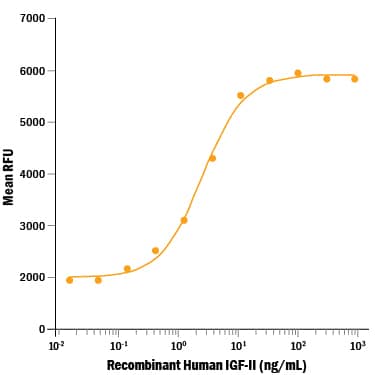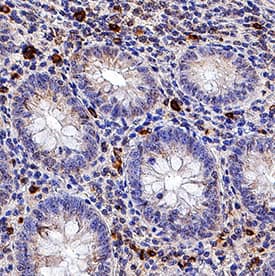Recombinant Human Galectin-4 Protein Summary
Product Specifications
Ala2-Ile323
Analysis
Customers also Viewed
Product Datasheets
Carrier Free
CF stands for Carrier Free (CF). We typically add Bovine Serum Albumin (BSA) as a carrier protein to our recombinant proteins. Adding a carrier protein enhances protein stability, increases shelf-life, and allows the recombinant protein to be stored at a more dilute concentration. The carrier free version does not contain BSA.
In general, we advise purchasing the recombinant protein with BSA for use in cell or tissue culture, or as an ELISA standard. In contrast, the carrier free protein is recommended for applications, in which the presence of BSA could interfere.
1227-GA
| Formulation | Lyophilized from a 0.2 μm filtered solution in HEPES, NaCl, TCEP, PEG and Trehalose with BSA as a carrier protein. |
| Reconstitution | Reconstitute at 50 μg/mL in sterile PBS containing at least 0.1% human or bovine serum albumin. |
| Shipping | The product is shipped with polar packs. Upon receipt, store it immediately at the temperature recommended below. |
| Stability & Storage: | Use a manual defrost freezer and avoid repeated freeze-thaw cycles.
|
1227-GA/CF
| Formulation | Lyophilized from a 0.2 μm filtered solution in HEPES, NaCl, TCEP, PEG and Trehalose. |
| Reconstitution | Reconstitute at 100 μg/mL in sterile PBS. |
| Shipping | The product is shipped with polar packs. Upon receipt, store it immediately at the temperature recommended below. |
| Stability & Storage: | Use a manual defrost freezer and avoid repeated freeze-thaw cycles.
|
Background: Galectin-4
Galectins are a family of carbohydrate-binding proteins with specificity for N-acetyl-lactosamine-containing glycoproteins. At least 14 mammalian galectins share structural similarities in their carbohydrate recognition domains (CRD), forming three groups often termed prototype (one CRD), tandem-repeat (two CRDs) and chimeric (one CRD, unique N-terminus) (1, 2). All lack classical signal peptides, but are present and active both within and outside of the cell. Galectins are involved in cell adhesion, migration, survival and apoptosis, and are often up- or down-regulated in cancer (1 - 3). Galectin-4 is a 36 kDa tandem-repeat galectin found throughout the gastrointestinal tract, but also present in well-differentiated breast and liver carcinomas (3, 4). Each CRD binds a different set of carbohydrate groups, including those found on red cell blood group antigens (3, 5). CRD1 also binds cholesterol 3-sulfate and other sulfatides, which are concentrated within lipid raft membrane microdomains (6, 7). Endocytosed Galectin-4 is thought to play a role in forming the rafts, delivering them to the intestinal apical membrane, and stabilizing highly detergent-resistant "superrafts" (7, 9). Human Galectin-4 shares 76%, 77%, 78% and 80% aa identity with mouse, rat, bovine and porcine Galectin-4, respectively, with the highest identity occurring within the CRDs. A potential splice variant begins at aa 132 and lacks most of the first CRD (10). Galectin-4 expression is concentrated within microvilli in the gastrointestinal epithelium, where it can interact with CD3 and bind activated T cells in the lamina propria during intestinal inflammation (11, 12). Either pro- or anti‑inflammatory activity has been shown, depending on the mouse model used. Galectin-4 can also bind lung, spleen and kidney macrophages, although its expression is normally low in these tissues (5).
- Yang, R-Y. et al. (2008) Expert Rev. Mol. Med. 10:e17.
- Elola, M. T. et al. (2007) Cell. Mol. Life Sci. 64:1679.
- Huflejt, M. E. & H. Leffler (2004) Glycoconj. J. 20:247.
- Recreche, H. et al. (1997) Eur. J. Biochem. 248:225.
- Markova, V. et al. (2006) Int. J. Mol. Med. 18:65.
- Ideo, H. et al. (2007) J. Biol. Chem. 282:21081.
- Delacour, D. et al. (2005) J. Cell Biol. 169:491.
- Braccia, A. et al. (2003) J. Biol. Chem. 278:15679.
- Stechly, L. et al. (2009) Traffic Jan 24 e-pub ahead of print.
- Entrez Accession # EAW56820.
- Hokama, A. et al. (2004) Immunity 20:681.
- Paclik, D. et al. (2008) PloS ONE 3:e2629.
Citations for Recombinant Human Galectin-4 Protein
R&D Systems personnel manually curate a database that contains references using R&D Systems products. The data collected includes not only links to publications in PubMed, but also provides information about sample types, species, and experimental conditions.
3
Citations: Showing 1 - 3
Filter your results:
Filter by:
-
Lectin nanoparticle assays for detecting breast cancer-associated glycovariants of cancer antigen 15-3 (CA15-3) in human plasma
Authors: J Terävä, L Tiainen, U Lamminmäki, PL Kellokumpu, K Pettersson, K Gidwani
PLoS ONE, 2019-07-25;14(7):e0219480.
Species: Human
Sample Types: Natural Protein
Applications: Bioassay -
Galectin-9 controls the therapeutic activity of 4-1BB-targeting antibodies.
Authors: Madireddi S, Eun S, Lee S, Nemcovicova I, Mehta A, Zajonc D, Nishi N, Niki T, Hirashima M, Croft M
J Exp Med, 2014-06-23;211(7):1433-48.
Species: Human
Sample Types: Protein
Applications: Bioassay -
Galectin-4 controls intestinal inflammation by selective regulation of peripheral and mucosal T cell apoptosis and cell cycle.
Authors: Paclik D, Danese S, Berndt U, Wiedenmann B, Dignass A, Sturm A
PLoS ONE, 2008-07-09;3(7):e2629.
Species: Human
Sample Types: N/A, Whole Cells
Applications: Binding Assay, Bioassay, ELISA (Standard)
FAQs
No product specific FAQs exist for this product, however you may
View all Proteins and Enzyme FAQsReviews for Recombinant Human Galectin-4 Protein
Average Rating: 5 (Based on 1 Review)
Have you used Recombinant Human Galectin-4 Protein?
Submit a review and receive an Amazon gift card.
$25/€18/£15/$25CAN/¥75 Yuan/¥2500 Yen for a review with an image
$10/€7/£6/$10 CAD/¥70 Yuan/¥1110 Yen for a review without an image
Filter by:













